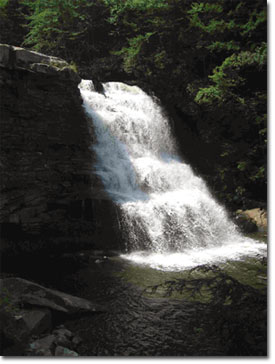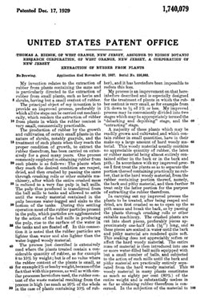The Vagabonds Camp at Muddy Creek Falls
By Francis Champ Zumbrun
“…we should be using nature’s inexhaustible sources of energy – sun, wind, and tide… I’d put my money on sun and solar energy. What a source of power! I hope we don’t have to wait until oil and coal run out before we tackle that. I wish I had more years left!”
- Thomas Edison (circa 1931)
Note: This is the fifth in a series of articles covering a time in the summer of 1921, when Henry Ford, Thomas Edison and Harvey Firestone camped for two weeks in western Maryland. This article finds the vagabonds, a term the wealthy captains of industry called themselves when camping together, at “Camp Harding” along Licking Creek, about 6 miles east of Hancock, in Washington County, where they stayed from July 21 to July 27. From here they traveled to present day Swallow Falls State Park where they camped from July 27 to July 31.
 On the afternoon of July 27, 1921, crowds of people, getting word that the vagabonds were in the area, started gathering along the streets of Oakland, Maryland, hoping to get a glimpse of the world famous men. The vagabonds sometimes caused a commotion when they arrived in a small town. One unknowing observer described the scene as the vagabonds entered Oakland as something like a circus coming to town.
On the afternoon of July 27, 1921, crowds of people, getting word that the vagabonds were in the area, started gathering along the streets of Oakland, Maryland, hoping to get a glimpse of the world famous men. The vagabonds sometimes caused a commotion when they arrived in a small town. One unknowing observer described the scene as the vagabonds entered Oakland as something like a circus coming to town.
The crowd was perhaps wondering: Would the vagabonds stop for supplies and food as they did in 1918, when they passed through Oakland on their way to a campsite in West Virginia?
On this 1918 trip, John Burroughs, the famed naturalist and writer, was traveling with them. Several versions of the following story survive; this one is my favorite:
Fred W. Besley, Maryland’s first state forester, assigned Abraham Lincoln “Link” Sines, a well known Garrett County State Forest warden, to serve as the vagabonds guide through Garrett County. Upon arriving in Oakland, they stopped at Naylor’s hardware store to pick up camping supplies. Link introduced the men to Mr. Naylor, the storeowner. The encounter went something like this:
Link said, “Mr. Naylor, I’d like to introduce you to
Thomas Edison; he invented that light bulb on your ceiling. This is Henry
Ford; he manufactured your car parked outside your store; and this is Mr.
Firestone; he made the tires that are on your car.” Mr. Naylor, by this time
a bit skeptical, looked at Link and said: “And I suppose you’re going to
tell me that this man [Burroughs] with the beard is Santa Claus!”
 In 1921, the vagabonds didn’t stop at Oakland, but continued on to Deer Park to eat a late lunch. Afterwards, they traveled about 9 miles on dirt covered roads to Muddy Creek. They arrived around twilight, and to their dismay, found a group of young boys camping at the premier spot they wanted next to Muddy Creek Falls. The vagabonds persuaded the boys with a ten dollar bill to move to another campsite further down stream toward Swallow Falls.
In 1921, the vagabonds didn’t stop at Oakland, but continued on to Deer Park to eat a late lunch. Afterwards, they traveled about 9 miles on dirt covered roads to Muddy Creek. They arrived around twilight, and to their dismay, found a group of young boys camping at the premier spot they wanted next to Muddy Creek Falls. The vagabonds persuaded the boys with a ten dollar bill to move to another campsite further down stream toward Swallow Falls.
A bridge on the road coming into their campsite caved in from the weight of the camp kitchen truck following the main party, blocking the road. As a result, no one from the public, except the young boys camping nearby, could visit them. This seclusion provided the vagabonds the greatest solitude they had known since they began camping together.
They set up their tents and cots just in time for darkness, ate a modest meal from tin cans, and then turned in after a long day of travel, sleeping an hour longer than usual the next morning.
The vagabonds were in great spirits. That first morning they stared at the Muddy Creek Falls for hours, sitting in canvas-backed lawn chairs, sharing humorous stories of their childhood, surrounded with the background music of the roaring waterfall, the songs of forest birds, with the fresh, whispering breezes gently rustling the ancient hemlock canopy above their heads.
Edison, Ford and Firestone are remembered more in history as industrialists rather than camping and their interest in the outdoors. Henry Ford, the wealthy captain of industry, often insisted he was in reality just a very simple man, a man of nature; a person who was an avid bird watcher and amateur astronomer.
 Thomas Edison’s inventions in history overshadow his interest and study of plants. However, his research involving plants contributed significantly to the success of some of his inventions. For instance, Edison studied over six-thousand plant specimens around the world before discovering that Japanese bamboo was the best organic fiber to use as a filament for the incandescent light bulb. Edison discovered that bamboo glowed and didn’t burn when an electronic current was passed through it.
Thomas Edison’s inventions in history overshadow his interest and study of plants. However, his research involving plants contributed significantly to the success of some of his inventions. For instance, Edison studied over six-thousand plant specimens around the world before discovering that Japanese bamboo was the best organic fiber to use as a filament for the incandescent light bulb. Edison discovered that bamboo glowed and didn’t burn when an electronic current was passed through it.
The last patent Edison filed before his death in 1931 also involved the study of plants. In the 1920’s, America was dependent on rubber from foreign sources. These countries were manipulating the market so that the cost of rubber was skyrocketing, negatively affecting our national security and economy.
To resolve this problem, in 1927, a business partnership was formed by Edison, Ford, and Firestone to find a more economical way to produce a domestic, supply of natural rubber to decrease our dependence from foreign sources.
 After studying over 17,000 plants over a four year period, Edison determined that the common goldenrod plant, which grows abundantly in the United States, was the best source to produce natural rubber economically. Through the hybridization of goldenrod, Edison was able to increase the production of latex, a component of rubber, from five percent to 12 percent.
After studying over 17,000 plants over a four year period, Edison determined that the common goldenrod plant, which grows abundantly in the United States, was the best source to produce natural rubber economically. Through the hybridization of goldenrod, Edison was able to increase the production of latex, a component of rubber, from five percent to 12 percent.
The quotation by Edison at the beginning of this article proves he was a green pioneer way ahead of his time, thinking about solar energy as a renewable resource as early as 1931.
Nevertheless, at Muddy Creek Falls in the summer of
1921, the vagabonds were more concerned about connecting with nature, than
about inventions and industry. As John Burroughs noted, the vagabonds were
seeking direct contact with nature, to "cheerfully endure wet, cold, smoke,
mosquitoes, black flies, and sleepless nights, just to touch naked reality
once more."
Photographs:
Photograph of Goldenrod, courtesy of L. Wiley.
Photo of Muddy Creek Falls courtesy of Roy Musselwhite.
Photo of Seminole Lodge, in Ft. Meyers, Florida where Edison studied
plants, courtesy of the U.S. Department of the Interior.
Edison's Patent Application for the Extraction of Rubber from Plants,
Dec. 17, 1929
Acknowledgements:
Maryland State Forester Francis Champ Zumbrun, author,
is the Manager of Green Ridge State Forest.
This is the fifth part of an occasional series about Thomas Edison,
Henry Ford and Harvey Firestone’s travels to Western Maryland,
originally published in the Cumberland Times News.
Back to Travelers Page